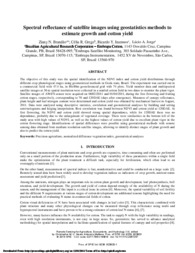Spectral reflectance of satellite images using geostatistics methods to estimate growth and cotton yield.
Spectral reflectance of satellite images using geostatistics methods to estimate growth and cotton yield.
Autoria: BRANDAO, Z. N.; GREGO, C. R.; INAMASU, R. Y.; JORGE, L. A. de C.
Resumo: The objective of this study was the spatial identification of the NDVI index and cotton yield distributions through different crop phenological stages using geostatistical methods in Goiás state, Brazil. The experiment was carried out in a commercial field with 47.4 ha, in 80x80m georeferenced grid with 74 plots. Yield monitor data and multispectral satellite images at 56 m spatial resolution were collected in a rainfed cotton field in two dates to monitor the plant vigor. Satellite images of AWiFS sensor were acquired on 08/02/2011 and 01/04/2011, during the first flowering and fruiting cotton stages, respectively, corresponding to 70 and 120DAE (days after emergence). Measures of canopy reflectance, plant height and leaf nitrogen content were determined and cotton yield was obtained by mechanical harvest in August, 2011. Data were analyzed using descriptive statistics, correlation and geostatistical analyses by building and setting semivariograms and kriging interpolation. Best correlation was found between NDVI and cotton yield at 120DAE. At first flowering, the NDVI and cotton yield showed strong spatial dependence, while for 120DAE there was no dependence, probably due to the enlargement of vegetated coverage. There were similarities in the bottom left of the study area with high values of NDVI, as well as the highest values of cotton yield due to excellent plant vigor in the cotton flowering stage. Identifications of spatial differences were possible using geostatistical methods with remote sensing data obtained from medium resolution satellite images, allowing to identify distinct stages of plant growth and also to predict the cotton yield.
Ano de publicação: 2014
Tipo de publicação: Artigo de periódico
Unidade: Embrapa Territorial
Observações
1 - Por padrão são exibidas publicações dos últimos 20 anos. Para encontrar publicações mais antigas, configure o filtro ano de publicação, colocando o ano a partir do qual você deseja encontrar publicações. O filtro está na coluna da esquerda na busca acima.
2 - Para ler algumas publicações da Embrapa (apenas as que estão em formato ePub), é necessário ter, no celular ou computador, um desses softwares gratuitos. Sistemas Android: Google Play Livros; IOS: iBooks; Windows e Linux: software Calibre.
Acesse outras publicações
Acesse a Base de Dados da Pesquisa Agropecuária (BDPA) para consultar o acervo completo das bibliotecas da Embrapa.

